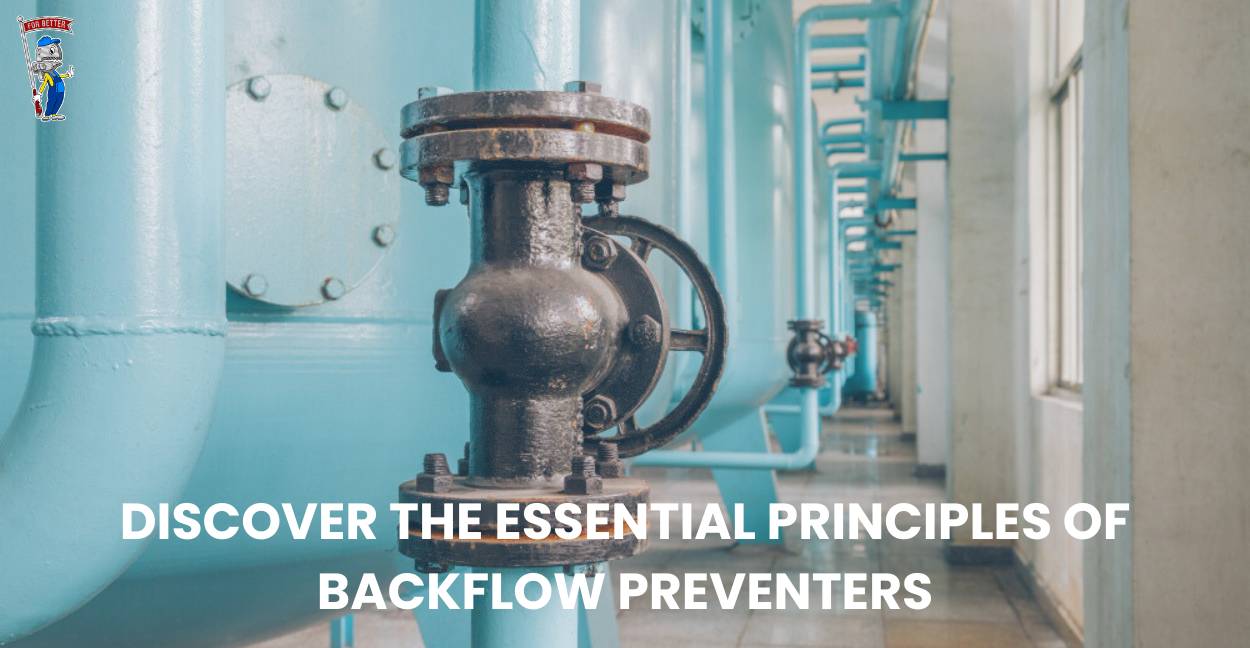Discover the Essential Principles of Backflow Preventers
Water is a fundamental necessity for life, and ensuring its purity is paramount. One of the significant challenges in water distribution systems is the potential for backflow, where contaminated water reverses its flow and enters the clean water supply. This is where backflow preventers play a crucial role, safeguarding our water sources from pollutants and maintaining water quality standards.
Purpose of Backflow Preventers
The primary purpose of a backflow preventer is to prevent the backward flow of water within a plumbing system. This backward flow, known as backflow, can occur due to various reasons such as a drop in pressure, back-siphonage, or back-pressure. Backflow poses a severe health risk as it can introduce contaminants, chemicals, or pollutants into the potable water supply, jeopardizing public health.
Key Principles of Backflow Preventers
- Mechanical Barrier: Backflow preventers operate on the principle of creating a mechanical barrier that hinders the reverse flow of water. This barrier is typically achieved through check valves, air gaps, or specialized devices designed to stop backflow under different scenarios.
- Pressure Difference Management: Managing pressure differentials is crucial in backflow prevention. When there’s a pressure drop in the supply line, it can create a vacuum, leading to back-siphonage. Backflow preventers are engineered to sense and counteract such pressure changes, maintaining a positive pressure gradient to prevent contaminants from entering the clean water supply.
- Cross-Connection Control: Another critical aspect is controlling cross-connections, which are points in the plumbing system where non-potable water sources (like irrigation systems or industrial fluids) can come into contact with potable water. Backflow preventers are strategically placed at these cross-connection points to block any potential backflow routes.
- Regular Maintenance: Ensuring the functionality of backflow preventers requires regular inspection, testing, and maintenance. This proactive approach helps identify and rectify any issues promptly, guaranteeing the continued effectiveness of backflow prevention measures.
- Compliance and Standards: Backflow preventers must comply with industry standards and regulations to ensure their reliability and effectiveness. These standards outline design specifications, installation requirements, and testing protocols, all aimed at safeguarding water quality and public health.
Types of Backflow Preventer Valves and Signs of Issues
Backflow preventer valves play a crucial role in maintaining the integrity of water supply systems by preventing the reverse flow of contaminated water into clean water sources. Understanding the different types of backflow preventer valves and recognizing signs of potential issues is essential for ensuring the safety and reliability of water supply systems. In this comprehensive guide, we will explore the various types of backflow preventer valves and discuss common signs of problems that require immediate attention.
Types of Backflow Preventer Valves
1.) Double Check Valve Assembly (DCVA)
- The DCVA consists of two independently operating check valves separated by a chamber. It is designed to prevent backflow in low-hazard applications such as irrigation systems and fire sprinkler systems.
- Signs of issues: Leakage from the valve, reduced water pressure, and visible signs of corrosion or damage.
2.) Reduced Pressure Zone Device (RPZD)
- The RPZD includes two check valves and a pressure differential relief valve. It offers protection in moderate to high-hazard situations, such as commercial buildings and industrial facilities.
- Signs of issues: Continuous discharge from the relief valve, water discoloration, and irregular water pressure fluctuations.
3.) Pressure Vacuum Breaker (PVB)
- The PVB is commonly used in outdoor applications like lawn irrigation systems. It prevents backflow by creating an air gap between the water supply and potential contaminants.
- Signs of issues: Water spraying or leaking from the device, malfunctioning check valves, and visible signs of wear or deterioration.
4.) Atmospheric Vacuum Breaker (AVB)
- The AVB is a compact and cost-effective backflow preventer suitable for low-hazard applications such as residential water systems.
- Signs of issues: Failure to seal properly, water leaks around the device, and reduced water flow.
5.) Double Check Detector Assembly (DCDA)
- The DCDA combines the features of a double-check valve assembly with the ability to detect leaks or unauthorized access. It is commonly used in high-security facilities and critical water supply systems.
- Signs of issues: Alarm activation indicating a potential leak or tampering, visible damage to the assembly, and irregular system behavior.
Signs of Backflow Preventer Valve Issues
Visible Leaks or Drips
Any visible leaks or drips around the backflow preventer valve indicate a potential issue with the valve’s sealing or functionality.
Changes in Water Pressure
Fluctuations in water pressure, including sudden drops or increases, can be a sign of backflow preventer valve problems such as blockages or malfunctions.
Water Discoloration or Odor
Discolored or foul-smelling water coming from faucets or fixtures can indicate contamination due to backflow, highlighting a possible valve failure.
Corrosion or Physical Damage
Visual inspection of the backflow preventer valve should include checking for corrosion, rust, or any physical damage that could compromise its effectiveness.
Alarms or System Warnings
Modern backflow preventer valves equipped with alarm systems may trigger alerts or warnings in case of malfunctions, leaks, or unauthorized access attempts.
Regular inspection, maintenance, and prompt repair of backflow preventer valves are critical for ensuring the safety and reliability of water supply systems. Understanding the different types of valves available and recognizing signs of potential issues empower property owners, facility managers, and maintenance personnel to take proactive measures and prevent water contamination incidents. By prioritizing backflow prevention measures and addressing valve problems promptly, we can safeguard public health and maintain the integrity of our water infrastructure. Remember, when it comes to backflow preventer valves, vigilance, and proactive action are key to ensuring clean and safe water for everyone.
Contact Backflow Services Done Right
Ready to protect your property from backflow issues? Our team of certified experts is here to help. Contact us today for a comprehensive backflow prevention assessment and tailored solutions that meet your specific needs. Don’t wait until it’s too late – safeguard your water supply with our trusted services. Get in touch now to schedule your consultation and ensure peace of mind for your home or business.



